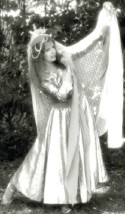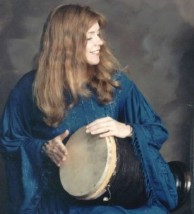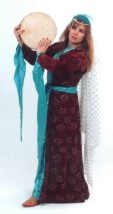|
Katherine St. John
|
|
CLICK AN IMAGE FOR LARGER VIEW
Katherine St. John was born in St. Paul, Minnesota, in November of 1948, in a neighborhood of post-WWII immigrants. Her family "was made up of French Canadian and British blokes." She always was excited to learn about the homelands of her friends and about their customs. To her, "it was so wonderful." Katherine tried to teach herself French from the Book of Knowledge series the family had in their vast library at home so she could claim some heritage other than Minnesotan. Her British grandmother lived with the family and she would imitate her grandmother's accent "in order to be exotic" like her friends from Germany, Italy, Poland, and Czechoslovakia.
Katherine took tap and ballet at the local community center and fell in love with ethnic dance at her first "Festival of Nations" when she was 10 years old as she sang German songs with her classmates. She went to "Festival of Nations" every year after that until she moved out of state in the 1980s. A woman from India, visiting her elementary school class, taught the kids how to put on a "sari" (an unstitched skirt comprised of more than 15 yards of fabric) and Katherine was hooked on ethnic costume from that moment on.
In the sixth grade, Katherine's school did a project in which the youngsters divided into groups and studied a country. Each group then represented the country studied in a special "booth." The students were given "passports" and visited all the country's booths as they "traveled the world." That experience, she says, is partly why she enjoys teaching children today about international dance, music, customs, and anything else she can share.
 In high school, Katherine continued dancing and performing in musicals and creating choreographies for school programs. After high school, she attended the University of Minnesota, studied Spanish and Arabic languages, and joined the Arab American club, becoming active in their many projects. Her interest in Middle Eastern culture led her to take "danse orientale" classes (popularly called "belly dance") of the day. Although very active, traveling around the country and studying with Jamila Salimpour, Dahlena, Serena, Jodette, the late and much missed icon of oriental dance Ibrahim "Bobby" Farah, and many others from coast to coast, she became unsatisfied and continued to do her own research and study about traditional music and dance of the Middle East.
In high school, Katherine continued dancing and performing in musicals and creating choreographies for school programs. After high school, she attended the University of Minnesota, studied Spanish and Arabic languages, and joined the Arab American club, becoming active in their many projects. Her interest in Middle Eastern culture led her to take "danse orientale" classes (popularly called "belly dance") of the day. Although very active, traveling around the country and studying with Jamila Salimpour, Dahlena, Serena, Jodette, the late and much missed icon of oriental dance Ibrahim "Bobby" Farah, and many others from coast to coast, she became unsatisfied and continued to do her own research and study about traditional music and dance of the Middle East.
Katherine performed extensively but mostly enjoyed the social dances of the Lebanese community, debkas, and casual party dances. In the early 1980s, she moved to Las Vegas, Nevada, and danced with the late Gil Delina and "with sweet and wonderful Dick & Donna Killian of the Ethnic Express," an international folk dance club. She continued her study, research, and performing, and learned Bulgarian songs and dances, which became her favorites. She went on to study Persian language and literature when she moved to Utah in the late 1980s. Then, it was on to Brighan Young University for dance training.
Katherine's close association with the Persian and Afghan communities created opportunities for her to learn and eventually to teach traditional dances from those areas. She is credited with introducing the North American dance community to the national folk dance of Afghanistan, the Atan and the Logari stop dance, the Shalangi clapping dance, as well as many others. She considers the legendary Dr. Lloyd Clifton "Doc" Miller as her "best pal" in her Persian studies and music and dance activities. (Dr. Miller is the founder of Eastern Arts, author of Music and Song in Persia: the Art of Āvāz (U of U Press, 1999), an ethnomusicologist who teaches Middle Eastern music at Brigham Young University, the director of the early Chicago jazz combo Roaring Twenties, and the director of the New Orleans jazz combo Salt City Saints.) For a year, Katherine rehearsed with the AVAZ International Dance Theatre of Los Angeles, California, although she was not in an actual performance. However, she is a director, musician, and dancer with the International Dance Theatre of Salt Lake City, Utah.
 Since around 1991, Katherine has been given academic opportunities that have resulted in papers for the Dance Ethnology Forum at the University of California at Los Angeles (UCLA). She has enjoyed presenting papers and sitting on panels for the Middle East Studies Association and the Society for Ethnomusicology. She also offers lectures with titles such as "Veiling Women in World History" (for the Utah Humanities Council Speakers Bureau) and "Dance and the Power of Representation in the Middle East and Central Asia" (at the Middle East & Central Asia Politics, Economics, and Society Conference).
Since around 1991, Katherine has been given academic opportunities that have resulted in papers for the Dance Ethnology Forum at the University of California at Los Angeles (UCLA). She has enjoyed presenting papers and sitting on panels for the Middle East Studies Association and the Society for Ethnomusicology. She also offers lectures with titles such as "Veiling Women in World History" (for the Utah Humanities Council Speakers Bureau) and "Dance and the Power of Representation in the Middle East and Central Asia" (at the Middle East & Central Asia Politics, Economics, and Society Conference).
Katherine has served as Secretary and President of the National Folk Organization (NFO) and artistic director of Eastern Arts. She also has served on several international festival boards in the state of Utah. She holds a Master's degree in Persian language and literature from the University of Utah, a Masters in Folkdance and Dance Pedagogy from BYU, and has completed course work toward a Ph.D. in dance theory at the University of California, Riverside (UCR). Her masters thesis at BYU was on Afghan dance based on study with Herati dancer and vocalist, Setara, now residing in Canada, as well as information from Afghan Herati, Izatullah Mujadeddi, and other Afghan natives. Katherine and Eastern Arts are on the Utah Arts Council (UAC) Artists in Education Roster and the Artistic Resources for Students and Teachers (A.R.T.S. Inc., formerly Young Audiences) roster. Her Eastern Arts group was on the State Office of Education Ethnic Artists Bank for several years.
 Katherine is a fine musician, playing percussion instruments, such as the "tonbak" (also, by usage, called a "zarb," a Persian hand-held goblet-shaped drum) and "dayere" (a large hand-held Persian tambourine-like drum) in the Eastern Arts ensemble and other musical groups.
Katherine is a fine musician, playing percussion instruments, such as the "tonbak" (also, by usage, called a "zarb," a Persian hand-held goblet-shaped drum) and "dayere" (a large hand-held Persian tambourine-like drum) in the Eastern Arts ensemble and other musical groups.
Although her dance expertise is in traditional, classical / staged dance from the Caucasus, Middle East, and Central Asia (countries once part of the ancient Persian empire), she enjoys all types of dance. She has taught international folk and Eastern dance classes at UCR, BYU, and the University of Utah (U of U) where she also was a Programs and Activities Director. She has created choreographies for Utah Opera, Lyric Opera, U of U Theater department. and U of U Character Dance Ensemble. Over the years, she has worked with the Ethnic Dance Theater of Minneapolis as part of the Middle Eastern Folk Ensemble of Minnesota, and has danced with the Ethnic Dance Ensemble of Nevada, and Živio Ethnic Arts Ensemble in Utah. She also sang with the Darena Balkan Womans Chorus. Katherine is the artistic director of World Dance Fever, an exciting, colorful collaboration of highly talented folk and ethnic dance groups and soloists from the Salt Lake Valley that celebrates music and dance of many nations.
Katherine has successfully expedited cultural projects funded by the Utah Humanities Council, including a photo exhibit and discussion on the Iranian cummunity in Utah entitled "Persian Profiles," a panel on the problems in Afghanistan after the Russian withdrawal, and other projects featuring various scholars and natives from Middle Eastern countries. She obtained a major grant from the California Council for the Humanities (CCH) for a project on the culture of Afghan refugees and immigrants in northern California entitled "Profiles of Afghanistan." She has secured other CCH grants for Persian and Turkish culture with the performance portion cofunded by the California Arts Council (CAC). One CAC project brought together Persian setar master Jelal Zolfanon and Afghan dutar master Izatullah Mujadeddi in concert at at the Middle East Studies Association conference in San Francisco. She taught at the Lark in the Morning Camp for two years where she offered songs and dances of Iran, Afghanistan, Israel, Lebanon, and other countries.
Katherine has worked with the Character Dance Ensemble at the University of Utah. She has created choreographies and arranged tours with the ensemble to Las Vegas for a Persian New Year event, to the Branson Missouri World Fest, and to England for a series of performances. Each November, she presents a WorlDance concert at Kingsbury Hall in Salt Lake City, Utah, with such featured guest artists as Latif Bolat, Banafsheh Sayyad, Anwar Yusuf, Ahmet Lüleci, and Aziz Herawi. She also does several residencies each year in Utah, teaching international folk dancing to students of all ages. Her company, Eastern Arts, does more than 50 school assemblies each year. She is available to provide performances, instruction, and choreographies, particularly in Kurdish, Afghan, Persian, Caucasian, and Central Asian dance.
Katherine says that the folkdance communities she has encountered throughout the world "represent the synergy of intellectualization and simplicity, a natural blend." She believes that we can gain more compassion for others and ourselves when we allow ourselves to take the time to enjoy the music, movement, and other aspects of our cultures. That is why she keeps on doing what she does.
Among Katherine's publications are
- "Ecstatic Dance - American Shakers and MNeflevi Dervishes" by Katherine St. John, BYU Dance Journal, 1992.
- "Music and Dance of Afghanistan: Amateur/shauqi vs. Professional/kespi" by Katherine St. John, BYU Danced Journal, 1992.
- "Pourparlor Speaks" with Karen Kaufman, et al; Country Dance and Song Society, CDSS News, Issue #171, March/April 2003. A multi-authored article about the 2002 annual "Pourparlor" gathering of people who teach dance in school and community settings, whidh took place at Folklore Village in Dodgeville, Wisconsin.
- Radif-E Raqs: Collection of Dance Sequences of the Persian Tradition by Katherine St. John, Mahera Harouny, and Lloyd Miller, University of Pennsylvania, 1987. Information about Persian musical instruments, dance, clothing, and constuming, and influences of other cultures.
- "A cultural and historical study of selected women's dance from Herāt, Afghanistan, 1970-1980" by Katherine St. John, Brigham Young University, 1993 (microform). Folk dancing in Afghanistan's Herāt province; Master's thesis.
Dances Katherine has taught include Attan (Atan), Bojnordi Chacani, Chepi, Garzani, Qashqai, Rashti, Shalangi, Sheikhani, and Torbat-jam.
